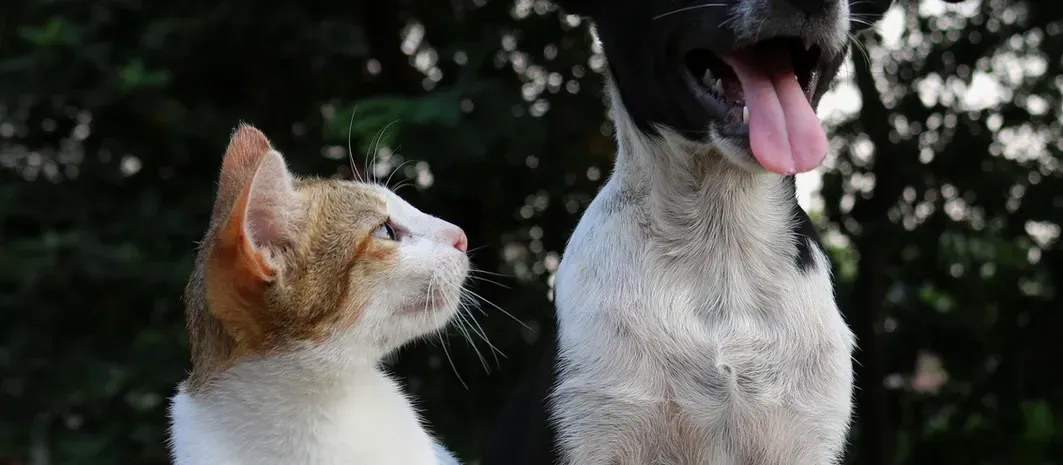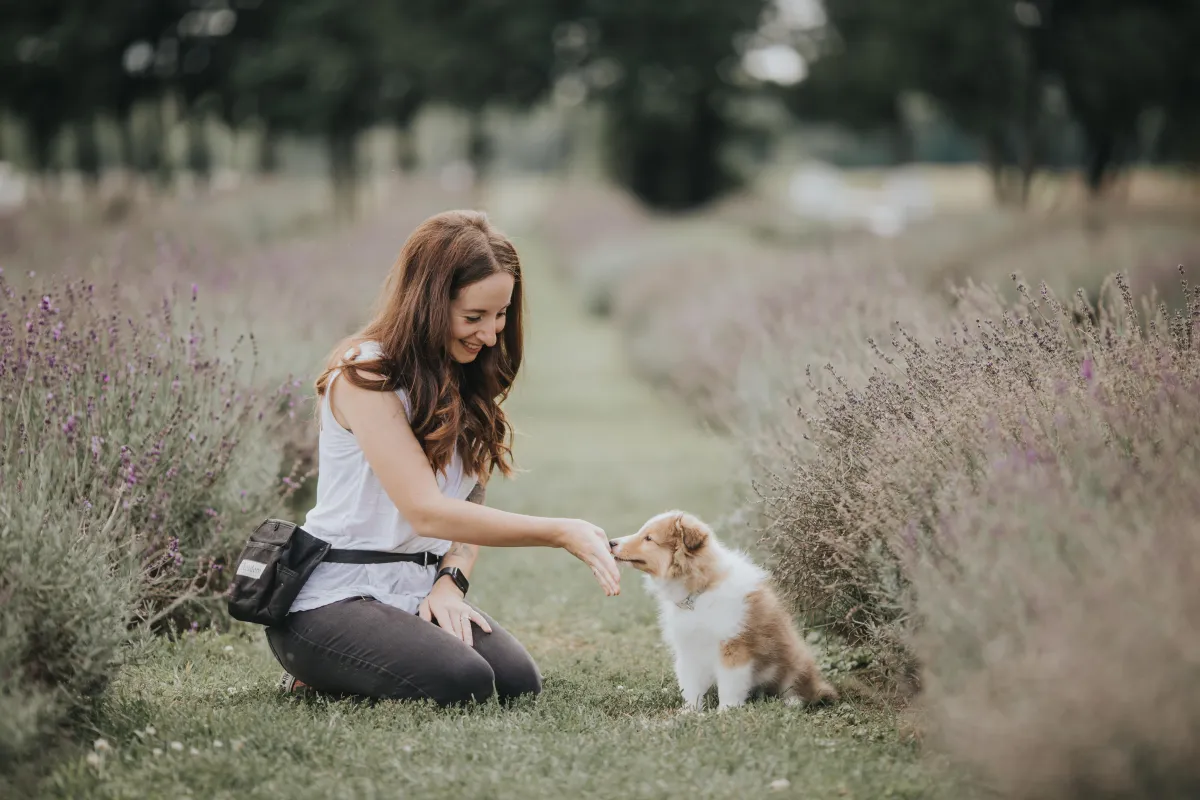Dog Inspired Blog
Guidance, Tips & Inspiration for Every Step of Your Dog’s Journey.

Introducing a puppy to a cat
Introducing a puppy to a cat
This week's post is all about introducing your puppy to your cat (however can apply to any type of dog-cat introduction!) and how to ensure everyone feels safe.
Your cat didn't ask for a dog, so we need to keep our expectations realistic. Will they ever be best friends? Maybe, but don't let social media cloud reality. We all love those heart warming stories and pictures of dogs and cats cuddling (I have a few photos of that of my own dogs and cats) but that's not how most cats and dogs are together. Many cat-dog relationships are just coexisting under the same room, while some can be much more stressful for a variety of reasons.
If your cat hasn't had experience with dogs, if your puppy has never met a cat, or if your puppy is a breed with a high prey drive, this can make it a little tricky. And we will do what we can to make this new change as positive as possible for both animals, as well as yourself!

The first meeting
When we first introduce our puppy to a cat there are a few things we want to have handy first:
Leash and harness for puppy
Baby gate
High value treats for puppy and cat
Space for cat to retreat higher up
If your cat has a history of being aggressive like going after ("attacking") other animals, I would also suggest keeping them on a leash and separate using a gate.
Ideally, sit in an open room. Keep puppy away from the doorways to avoid blocking your cats access to leave should your cat feel like they have had enough. Puppy will need to be on leash and a harness (we don't want puppy slipping out and chasing the cat). You can also use a gate with your cat on the other side, but keep in mind that they might jump over if they are extra food motivated, so leashing your puppy is a solid management strategy.
I want your puppy to see the cat and you will use your treats to redirect and reward all good behaviours. For example, if puppy stares at the cat, place a treat in front of their nose and toss it in another direction to redirect their attention else where.
If your puppy looks at the cat but lays down, looks at you or looks for their toy: praise and reward this! Your puppy made a decision not to focus on the cat!
For your cat, have a partner who can also feed them treats or you can toss a treat to them but this might get puppy excited so be sure to redirect puppy when you toss the cat a treat. The goal for this exercise is to create a positive first experience between the cat and the puppy. For the cat, puppy = treats. And for your puppy, not bugging the cat = treats.
These introduction sessions should not last more than 3-5 minutes. We don't want to overwhelm the cat and your puppy has a short attention span so it's best not to push. They can be repeated a few times a day.
Continued management
As you work on these introductions between the cat and the new puppy, you will want to ensure that puppy does not have an opportunity to get into the cat's bubble or chase them. Ideally, your cat and puppy should see each other often through passing, I don't want either to be sequestered as this can make the cat more interesting to the puppy.
Baby gates: Having a gate to make a part of your home puppy-free. Ideally we want your cat to have enough space to move around, as well as have to choice to come into the common areas if they feel comfortable (as opposed to locking them in a bedroom). Baby gates also allow for a visual, they can still see each other without having access.
Crates: Most puppies are not crate trained, you won't want to just put puppy in there because this can be quite distressing. However with some crate training, puppies can feel happy in their "home", which can also be a perfect way to manage your puppy and cat's interactions
Leash: Keeping puppy on leash is a great way to manage them when they are roaming around. You can tie the leash around your waist so puppy follows you as you go about your business.
Cat highway: provide your cat with shelves, cat trees or tall furniture to travel on to get across a room. This will allow your cat height to continue observing puppy (and puppy can also see the cat), without feeling threatened. If your cat has to run across the room to get to safety, this will trigger them acting like prey.
Puppy-free space: Your cat will need a puppy-free space. This can be a floor in your house or a room where they have access to their litter box, food, water and a comfortable place to sleep away from puppy. (you also don't want your puppy eating cat litter... yuck!)
Cats are prey animals
And they react as such! When they feel scared, your cat will run and this will trigger puppy to chase. Which is a recipe for disaster! Not that your puppy will hurt your cat, but this can be very traumatic for the cat. It's also an interaction (and a habit) I want your puppy to avoid creating.
There are some breeds that have a higher prey drive. Prey drive is the instinctive inclination of a carnivore (like your puppy) to find, pursue and capture prey. Having a prey drive is normal and for a lot of breeds, part of who they are. It's something to keep in mind when choosing a puppy. Some breed examples include hunting dogs, terriers, and herding dogs like pointers, rat terriers and border collies.
In my experience, most dogs have a prey drive, to a certain extent. It does not mean your dog is bad or aggressive, but part of being a dog. For example, my dogs will chase every squirrel, bird and stray cat that comes in or near our backyard. They have caught a cat on a few occasions and they had no idea what to do once the cat was cornered. And with my cat, they have never chased her or shown an inch of prey drive towards her.
There are some extremes to this behaviour like being so fixated when they see a small animal or if they have a history of killing small animals. But this is really a case by case basis.
What's most important is to be observant of your puppy's behaviour around the cat, practice the introduction exercises and continue managing until your cat and puppy seem to either coexist or maybe become friends.
If ever you feel your puppy's behaviour towards your cat is worrisome, I strongly encourage you to reach out so we can help assess the situation and give you personalized coaching.
To resume what we want to focus on with puppies and cats:
Create positive associations to one another using food
Use gates, leash and other forms of management between introduction exercises
Provide your cat with a puppy-free space
Keep an eye out for prey-drive behaviours
Be sure to reach out should you need personalized guidance!
Happy Training!

Let's Work Together
Whether you’re just bringing home a puppy or you’ve already started your service dog training journey, Dog Inspired is here to help you every step of the way.
Service Areas: Deux-Montagnes, St-Eustache, Laval, Montreal
